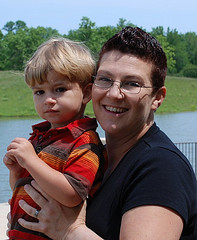By Judy Arnall, author of Discipline without Distress, www.professionalparenting.ca
 “But you don’t have to sleep alone!” Kyle protests to his mom when she suggests he sleeps in his own room. Family bedrooms are increasingly becoming common in Western societies, thanks to the Attachment Parenting movement that recognizes that babies and toddlers are not developmentally ready to sleep on their own for the first few years of life. However, Kyle is seven years old. The prevalence of family bedrooms among families with school-age children has not been studied, let alone talked, but the trend is growing.
“But you don’t have to sleep alone!” Kyle protests to his mom when she suggests he sleeps in his own room. Family bedrooms are increasingly becoming common in Western societies, thanks to the Attachment Parenting movement that recognizes that babies and toddlers are not developmentally ready to sleep on their own for the first few years of life. However, Kyle is seven years old. The prevalence of family bedrooms among families with school-age children has not been studied, let alone talked, but the trend is growing.
Many children, especially those that don’t have siblings to snuggle in with, continue to sleep in the same bedroom as their parents, well into the school-aged years. Many families do not admit that they sleep with their children. The fear of being investigated by child welfare authorities is the biggest barrier against discussing this practice. So the practice occurs quite often, but is not openly admitted. As a society, we accept family bedrooms for motels rooms, visiting at relatives, camping, and vacations but not for everyday use in a society that values independence at all cost. Still, parents persist. “We cosleep because it’s a cultural choice. My husband is Vietnamese and I am Canadian, and we have decided that it’s what works best for our family. Back in Vietnam my husband’s sisters still sleep with their mother, and my husbands’ brother and father also share a room. The younger ones are all in their 20s and it is not illegal or abnormal or culturally odd like it is here,” says Cheryl, mom of two children.
How does a family bedroom work? Two hundred years ago, before the invention of central heating, most of the family slept in the same room if not the same beds. Fast forward to the 21st century, where bedrooms now have the square footage size of the average 1950s house, the family bedroom can easily accommodate two king-size mattresses on the floor or several beds in the same room.
Not everyone agrees with the concept of a family sharing sleep in the same room. Barbara Evans, a parent educator from Beaumont, Texas USA, worries about the parent’s need for privacy and intimacy. “My concerns are that, as parents, our job is to raise healthy, loving and lovable, independent children. Not to the exclusion of depriving them of nurturing and cuddling, but this may be the first place to start learning about boundaries and self-care.”
Why do families choose a family bedroom? No separation anxiety issues and no bedtime battles is the biggest reason. For an increasingly separated family where both parents might work out of home full-time and children are away at school, it is comforting and enjoyable to cuddle together at the end of a busy day. “The best thing about having the kids there with us is the emotional bond we have with them. We love the time upstairs to talk in bed, read, write, or just watch TV together. There’s no separation between us and we don’t send our kids away at night to be alone unless they want to,” says Ally, mom of three children. They have a big master bed for the parents and two mattresses on the floor on either side of the master bed for the children.
What age should family bedrooms stop? Children naturally develop the desire for more privacy at puberty and tend to want their own room and sleeping space by age 13. This occurs naturally whether they sleep alone, or share a bedroom with siblings or with parents.
Most experts agree that the rules are simple. Generally, all members of the family must wear night clothes. Whoever doesn’t like the arrangement and says “no” should have their wishes honored whether they are the parent or the child. The parents might enjoy the closeness, but if their eight-year-old son wants his own room, that should be respected. And of course, couple sexual intimacy must take place in another room.
Former Canadian Prime Minister Pierre Elliott Trudeau once said, “The government has no business in the bedrooms of the nation.” And for many families, that rings truer than ever.
Q: Every night, I put my 13-month-old daughter to sleep in our family bed, but shortly afterward, she wakes up and I have to start all over – breastfeeding her and helping her fall asleep. This keeps happening, and I cannot stay up with my husband so we can have a bit of time for ourselves. She also wakes up a lot at night. How can I help my toddler to stay asleep?

 By Sonya Fehér, contributing editor for the
By Sonya Fehér, contributing editor for the 